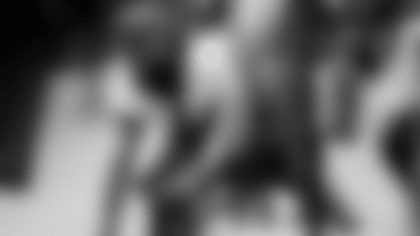If the NFL is the copy-cat league it's said to be, look for a new awareness for the importance of rushing the passer in 2008. That's what the Giants' Super Bowl victory is likely to have caused.
The Giants sacked Tom Brady five times in doing what no other team had been able to do through the regular season and AFC playoffs. The Giants beat the Patriots the old-fashioned way: The quarterback went down and the quarterback went down hard.
"They mixed it up great on them and won in their four-man rushes," Jaguars defensive line coach Ted Monachino said of the Giants.
Monachino was asked by jaguars.com to take a look at the game tape of the Giants' Super Bowl win and provide an analysis of what the Giants did and how they did it. Here's what Monachino determined.
• Of the Patriots' 54 pass plays, the Giants were using a four-man rush with zone pass-coverage in the majority of those plays.
• The Giants used a zone-blitz scheme seven times and won six of those seven times.
• Man blitz was used six times and the Giants won in three of those instances. The Giants' first sack of the game occurred in a man blitz.
• Defensive end Justin Tuck was creatively used as a stand-up defender in a three-man look. Tuck would stand behind the nose tackle and then move in between the nose tackle and one of the ends just before the ball was snapped, and Tuck and the defensive end would often execute a stunt or twist pass-rush technique.
"Twenty-nine clean one-on-one wins. That's
29 guys at the quarterback when the ball is thrown," Monachino said.
So what are we to take from the Giants' pass-rush success? What blueprint did the Giants provide for every other team in the league to copy?
"I think they showed us is that they're finding body types at all those spots and they're finding athletes who are capable of winning at a variety of spots," Monachino said.
In other words, the Giants' winning strategy is having spent the past several years collecting pass-rushers?
"I would absolutely agree with that, but it's the body-type guys for whom you don't have to sub guys out of the game," Monachino said, referring to every-downs defensive ends, such as Michael Strahan, Osi Umenyiora and Justin Tuck.
"There has been a premium on those type of guys and this just confirms it," Monachino added.
A lot of the credit must go to retired personnel boss Ernie Accorsi, who understood the need for collecting pass-rushers. Before Accorsi retired, he gave the Giants one more every-downs defensive end, Mathias Kiwanuka, who is on the Giants' injured reserve list.
Look for every team in the league to put an even greater premium on every-downs defensive ends in free agency and in the NFL draft this year. Based on the Giants' win over the Patriots, this could become the year of the defensive end.
Monachino likes what he sees in this year's potential free-agent class, aware, of course, that headliners such as Jared Allen and Terrell Suggs are likely to be assigned "franchise" tags.
"I think it's deep with every-downs body types and it's a very attractive class for those pass-rush types," Monachino said.
In addition to their five sacks, the Giants also got 12 hits on Brady and Monachino said he thought Tuck or Umenyiora should've been selected MVP, but that's not to say Giants Defensive Coordinator Steve Spagnuolo wasn't a star in his own right.
"They identified and broke down the (Patriots') protectors more than they broke down the protections. Strahan knew how to beat each guy he was going to line up on. They had studied what gave those guys fits and worked them for the entire game," Monachino said.
In other words, the Giants schemed personnel more than they schemed schemes.
"What they were able to do is combine the best things each team did against them. The Ravens mixed their three and four-man fronts with pressure. The Giants proved in week 17 they could pressure them with a four-man rush and play zone behind it. I think we proved that if you could eliminate the big play you're going to be in the game at the end of the game. It's OK to let Brady be efficient, you just can't allow him to beat you with big throws. As long as you keep the short throws short, you've got a chance," Monachino said.
It also helped the Giants' cause that the Patriots stayed in their four-wide and five-wide receivers looks for much of the game, even though it played right into the Giants' hands. Why did the Patriots continue to invite the rush?
"That's what they do. They were trying to force feed them what they do," Monachino said, referring to the Patriots' spread formations. "(The Giants) had two distinct plans. In the first half they pressured them. In the second half, they changed coverages. They took the aggressiveness out of the front and put it in the back by using extra defenders."
And the rush just kept coming.














